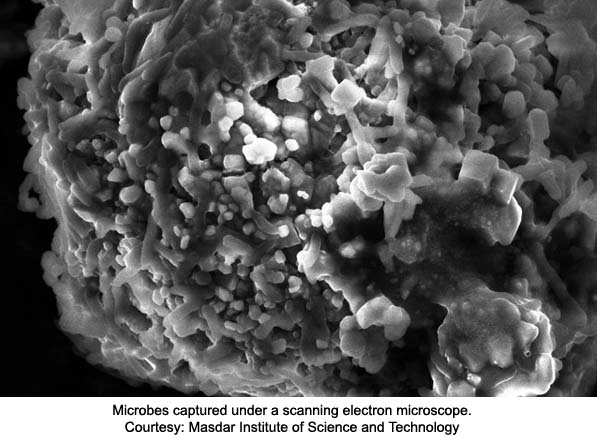ID :
362381
Mon, 04/06/2015 - 09:18
Auther :
Shortlink :
https://oananews.org//node/362381
The shortlink copeid
UAE scientists working on catalogue of “alien” microorganisms

ABU DHABI, 6th April, 2015 (WAM) -- Scientists in the UAE are in the process of creating a data base to identify non-indigenous microorganisms that pose a threat to human and native marine life, carried by sandstorms over thousands of kilometres which bear viruses and diseases not native to the region, affecting human health.
According to a report by The National daily, a team from Masdar Institute of Science and Technology is cataloguing naturally occurring microorganisms in an effort to better identify ''alien'' species that hitch rides on tiny dust particles. They can travel from as far away as North Africa and Mongolia, bringing diseases with them.
The team, led by Dr Hector Hernandez, has spent more than 18 months collecting and analysing samples to build a database of local species that will allow them to identify when alien microorganisms enter the air.
"We’ve been trying to collect these samples and build a library of what’s here. If you build this catalogue, you can tell when newcomers come in because they’re different to what you know is here. There are early detection systems so when you test the environment, you can tell if there is a new organism. It’s particularly important if you know it’s one that causes disease," said Dr. Hernandez.
The early detection systems that could be used when the catalogue is complete are quantitative as well as qualitative, so when the numbers of microorganisms reach a threshold, public health officials could issue alerts and take better preventive measures.
Last week UAE saw some of the worst dust storms in recent years, with visibility reportedly down to less than 100 metres in some parts of the country.
That disease-causing microorganisms travel in dust storms is relatively new to scientific knowledge. Up until recently, or at least within the past 10 years, the prevailing opinion was that the effect of the small particles in dust storms was limited to suppressing the immune system and aggravating existing respiratory conditions.
A 2011 study released by the Centre for Naval Warfare Studies, US Naval War College, Rhode Island, found that dust particles tested in Kuwait and Iraq carried very high levels of metals and microbial matter.
More than 147 different types of bacteria were isolated, including some that showed antibiotic resistance.
Those found in the samples included Staphylococcus aureus, the resistant form of which is known as MRSA, malaria-causing Neisseria meningitidis, and Acinetobacter baumannii, a superbug linked to severely injured soldiers and which targets the seriously ill, the daily said.
In Abu Dhabi Emirate, there are 20 air monitoring stations dotted across the cities and desert. Monitored by the Environment Agency Abu Dhabi, they collect data on the levels of particulate matter in the air, which are known to be damaging to human health.
The largest concern is the tiny particles of matter that travel deep into the lungs. They are identified as PM10 and PM2.5, which refers to diameters in micrometres.
According to 1999 rules, PM10 levels in the country should not exceed 150 microgrammes per cubic metre in 24 hours. The global guideline from the World Health Organisation is a third of this figure. WHO says this is to encourage "a gradual shift from high to lower concentrations". Some countries issue public health warnings about air quality if the levels are expected to rise above recommended guidelines.
Up to 70 percent of the small particulate matter floating in the air comes from the natural desert environment, and the remainder is caused by humans.
"The bigger problem that is not being addressed and not being looked at is the microorganisms that travel in the clouds and in the clouds of dust. They attach to the sand particles and when you breath them in, they land in this beautiful environment," Dr. Hernandez says.
"There is an even temperature, fluid and food, so they grow. The growing is when the respiratory diseases arise. They’re not like flus that are caused by viruses. So it’s not like you have the flu, you actually have a respiratory disease."
A catalogue of existing, local microorganisms would assist the health authority in identifying particular respiratory diseases that rise rapidly during dust storms when particles are coming in from elsewhere.
"We have storms that start in Syria and Saudi Arabia, and they will be here in half a day. It takes a day for some of them that start in North Africa to come over here. Then you have Mongolia that comes down when the wind goes the other way.
Dr. Hernandez and his team use a sequencing method to identify local organisms.
"We now have ability to analyse a million, a hundred million of them at the same time. I can take a sample and extract the DNA from that sample and I can look for a marker, a gene, and align the sequence in those genes because it’s DNA. Then I can make a map of how related they are to each other, and that gives me an idea of what’s there." – Emirates News Agency, WAM –
http://www.wam.ae/en/news/emirates/1395278904403.html





